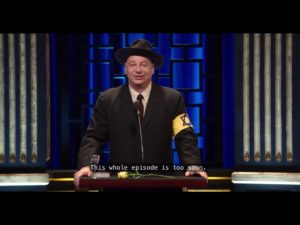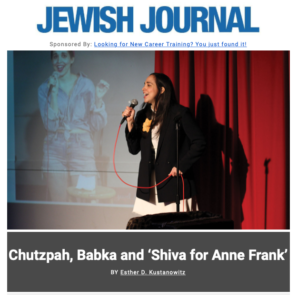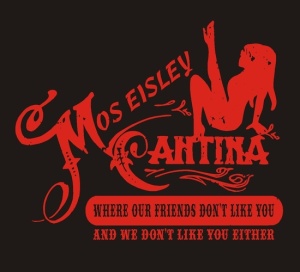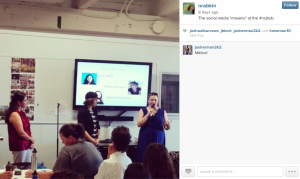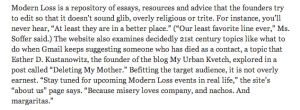Online Clips Archive

Netflix-and-Kvell-and-Purell: Jewish-Themed & Israeli TV to Watch While Quarantined
0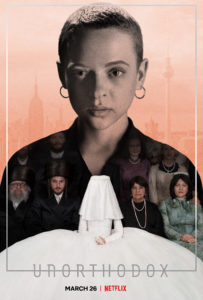 If you’re quarantined, self-quarantined or just playing it safe and socially distant, you’re probably logging a lot of hours on devices consuming entertainment.
If you’re quarantined, self-quarantined or just playing it safe and socially distant, you’re probably logging a lot of hours on devices consuming entertainment.
Good news is that there’s lots of content to choose from: here’s my first list (of undoubtedly several) to keep you entertained while you’re staying safe and the world figures out what’s next.
Comedy? Drama? A combination? Brand new shows and classic films?
Check them all out here at the J..

One Comedian Holds “Shiva for Anne Frank”; Another Roasts Her: The Challenges of Holocaust Comedy
0Anne Frank’s birthday is June 12. In honor of her life and work, I wanted to share two recent pieces I wrote about Anne, and take a look at some of the current media conversation about her.
Comedy and the Holocaust
The Holocaust is not funny. We all know that. And yet, there is comedy being performed about things associated with the Holocaust that some people do find funny. This line is a difficult one to walk and is explored very well and, I think, respectfully, in the documentary “The Last Laugh.” That film, containing jokes and serious interviews with comedians, makes points about Jews’ survival and ridiculing Nazis as taking away their power. (Trailer at end of this post.)
Roasting Anne Frank
This month, Netflix released a new series by Jeffrey Ross called “Historical Roasts,” including a “roast” of Anne Frank. The internet rebelled, with many calling on people everywhere to insist that Netflix cancel and remove the whole series. Most of these people had not seen the show and proudly proclaimed they wouldn’t even watch a few seconds of it in protest; they were rebelling in knee-jerk reaction to the sheer idea of a comedy roast of the beloved diarist. They didn’t understand Ross’s motivations, or they didn’t care. They thought the show was laughing at Anne Frank. (And the word “roast” in a Holocaust context is really in poor taste, but that’s what the genre is called.) But Ross said in a Jewish Journal interview that he was acting out of educational goals, but through a genre – comedy roasts in which the guest of honor is insulted by “friends” and then has an opportunity to fight back with their own insults – that he has become known for:
“As a comedian, you do things that no one’s ever done, and roasting Anne Frank sounds outlandish, it sounds risky, but to me, the riskier move would be to ignore the most provocative and the most emotional stories,” Ross said. “People always talk about the Holocaust and they say ‘never forget,’ but young people, I’m sorry, they are forgetting. They need to hear these stories, and I use Anne Frank not just as a hero from World War II but as a cautionary tale of today and anti-Semitism.”
Anne and Rachel at the Fringe
In this year’s Hollywood Fringe Festival, writer and comedian Rachel McKay Steele has a one-woman show about Anne Frank, or more accurately, about how her life is inspired by Anne Frank’s work. The show, “Shiva for Anne Frank,” got a little sexually explicit at parts, and is often more about the author than the diarist. It will undoubtedly elicit some knee-jerk reactions to the concept. But Steele points out that Anne herself, even within her dire circumstances, had a wry sense of humor. It’s possible she would have enjoyed a good roast, or Jewish comedians identifying with parts of her story or with the observations she made in her diary. As with the roasts, the ability to sit and absorb the culture of this show is about understanding the genre and suspending your inner critic to see the truths within, even if you find some of the trappings offensive.
Let’s Talk
So what role should contemporary tools – like social media and various types of comedy or commentary – play in retelling the sacred stories of our tragic past? Is it always going to be “too soon” to joke about tragedy? Are remembrances only permitted to be somber, or can we infuse serious memorials with humor?
Read “Chutzpah, Babka and ‘Shiva for Anne Frank,'” my interview with writer and comedian Rachel McKay Steele, in the Jewish Journal.
Read my piece, “Anne Frank Friended Me: Social Media and Remembering the Holocaust,” in eJewishPhilanthropy.
Trailer for “The Last Laugh” (2016)

The Marvelous Mrs. Marketing–oops, I Meant “Maisel” (& more!)
0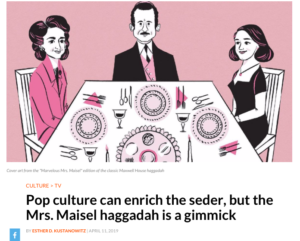 That’s right. I said it. I’m the grinch who stole Passover. I’m the “Marvelous Mrs. Maisel” fan who doesn’t want a Maisel-themed Haggadah for her Passover seder. But I do wish that when these religion-and-pop-culture mashups happen, that they do so in a way that enriches either the religious source material or the pop culture text, and this collector’s edition did neither–it was simply a marketing gimmick. The Maxwell House Haggadah is known for its accessible simplicity. And I can respect that, even if it’s not what I find meaningful during the Passover holiday. But I am the kind of person who likes to dive deep into culture and text, to look for meaning.
That’s right. I said it. I’m the grinch who stole Passover. I’m the “Marvelous Mrs. Maisel” fan who doesn’t want a Maisel-themed Haggadah for her Passover seder. But I do wish that when these religion-and-pop-culture mashups happen, that they do so in a way that enriches either the religious source material or the pop culture text, and this collector’s edition did neither–it was simply a marketing gimmick. The Maxwell House Haggadah is known for its accessible simplicity. And I can respect that, even if it’s not what I find meaningful during the Passover holiday. But I am the kind of person who likes to dive deep into culture and text, to look for meaning.
What might I have done instead? Try to look at the Maisel characters through a Passover lens. Take the Four Children: Wise, Wicked, Simple and Unable to Ask a Question…Midge Maisel (nee Weissman) spends years not knowing how to ask for what she wants, but then gets wise about it, rendering her wicked in the eyes of father, Abe, a wise man (phonetically, Weissman!) whose worldview is rigid and simple. Rose demands her daughter conform to a simpler life, but because she herself doesn’t know how to ask for what she wants, she flees her life (wicked?) and country to reconnect with an old path. And in the newest season, we find out that the son, living a life at a frequency that seemed much simpler than Midge’s, is using that simplicity as a cover for a complicated government life. Maisel characters–and people–are complicated.
For more about how I’d bring pop culture into the Four Children context, check out my latest in the J. And you can check out past pop culture/Passover pieces at my Haggadot.com author page (where you can make your own meaningful Haggadah!)
(Thanks for reading – will try to keep this space more updated in the future.)

What have I been up to? Check out these handy author pages!
0It’s been a while since I’ve posted over here, but that’s because I’ve been busy writing up a storm in various places…the best way to catch my writing is usually at GrokNation.com or JewishJournal.com, so here are some handy author links to save you a Google. 🙂
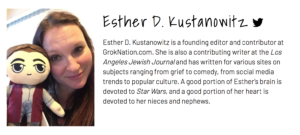 Looking for my TV, film and other pop culture pieces; social media commentary; or various news-related stories? GrokNation.com can help you with that. 🙂 Here are some recent Grok pieces I’m particularly proud of:
Looking for my TV, film and other pop culture pieces; social media commentary; or various news-related stories? GrokNation.com can help you with that. 🙂 Here are some recent Grok pieces I’m particularly proud of:
- Hollywood’s Scum & Villainy Cantina: where all fandoms are welcome
- The movie ‘Grease’ turns 40, and we’re conflicted
- Sarai Walker, author of ‘Dietland,’ on her book and the new AMC series
- May the faith be with you: Star Wars and religion
- In ‘I Feel Pretty,’ Amy Schumer’s traumatic brain injury leads to transformation
If it’s Jewish community stories or Jewish-thought-related articles that you fancy, the JewishJournal.com site is the one for you! Here are some of my newest pieces from the good ol’ JJ:
- Modern Jewish Matchmakers Urge Singles to Keep Their Hearts and Minds Open to Love
- The Jewish Geography of — and in — Auschwitz
- For Jewish Scholars Analyzing TV’s ‘Crazy Ex-Girlfriend,’ the Rest Is Commentary
- Twitter and the Responsibility of More
- MADE IN ISRAEL: How Israeli Shows Are Transforming Television
Thanks for stopping by – hoping to have a site revamp and/or more content here soon!!

My Jewish Journal Life…
0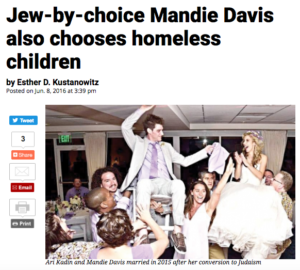 Since February 2015, in addition to my various other consulting work, I’ve been a contributing writer at the Jewish Journal here in Los Angeles, and have had the opportunity to tell some amazing stories – some about myself, and some about other people.
Since February 2015, in addition to my various other consulting work, I’ve been a contributing writer at the Jewish Journal here in Los Angeles, and have had the opportunity to tell some amazing stories – some about myself, and some about other people.
You can read all of my past stories – including a few “classics” from years before I even moved to Los Angeles! – at my author page on the Jewish Journal website. And here is a curated list of some of my 2016 favorites so far.
Jew-by-choice Mandie Davis also chooses homeless children: Southern Baptist-raised, and now Jewish, Mandie found love on Skid Row, and co-founded an amazing organization with her husband that brings joy to homeless children for their birthdays. (June 2016)
Today’s Jewish TV characters come into their own: An exploration of how Jewish identity is totally a thing on television these days, as characters own their cultural identity, traditions and even Hebrew in an unprecedented manner. (April 2016)
Finding meaning in Passover prep pain: A personal piece recalling how much pain my late mother endured in creating Passover in our home, and how I created Passover in my home this year. (April 2016)
Reconsidering Kaddish: Profiling four new approaches to the mourner’s prayer, which expand access to Kaddish as a ritual and imbue it with new meaning. (February 2016)
More available at my author page, and in the future, as I cover additional topics…

What’s New? Star Wars & Grief; Bar/Bat Mitzvahs; Calling Out the Patriarchy, and more!
0I’ve been writing a lot, mostly for the Jewish Journal, where I’m now a Contributing Writer. But I’m not exclusive to them, so I’ve been a writer who’s still playing the field a little – this gives me the chance to explore lots of different topics, for instance:
There are currently six episodes of the Star Wars saga. Which order do you watch them in? And what did considering Episode Order or Release Order teach me about coping with loss? Read about all that stuff, including some super nerdy mentions of Mos Eisley spaceport and the Kessel Run, in “Star Wars: Episode Infinity: The Force of Grief,” this new piece at ModernLoss, just in time for the second Star Wars Day (May 25, the date that was declared “Los Angeles Star Wars Day” back in 2007 – and which has marked several noteworthy Star Wars connections…).
“Think back to the last panel or conference you attended, Jewish or otherwise. Do you remember any of the speakers? Were they men or women? If you don’t remember a lot of women speaking at your last conference or panel experience, there’s probably a reason: They may not have been there.” In “Calling out the Jewish Patriarchy, One Blog at a Time” (Ha’aretz), I did a rundown of the blogs that are calling out the patriarchy – inside and outside of the Jewish world – for all-male panels and boards.
I lost my phone on Mother’s Day. Then an app and the internet and a local friend and a stranger helped me find it. And then I wrote about it all at my blog, in “iLost & iFound.” (Also at my blog, a rundown of a local event featuring Gideon Raff, the creator of Hatufim, Homeland, Tyrant and Dig.)
Bar and Bat Mitzvahs are known as a time when Jewish boys and girls come to adulthood – but they have also become an excuse for excess, for elaborate celebrations that barely connect to Jewish practice and responsibility. In “Thou Shalt Party,” this tongue-in-cheek piece for the Jewish Journal, I took ten Torah portions and identified ways in which they could be tied to contemporary events, pop culture and wacky celebrations.
Read, enjoy, and if you’d like, feel free to pass these stories along to someone who’d enjoy them…

God, Prayer & No Traffic from San Diego to Los Angeles
0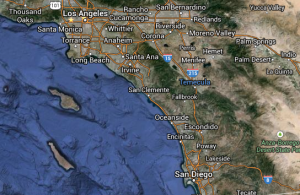 I’d love for this to be an instructional story about how to effectively request and obtain Divine intervention that yields a traffic-free journey between cities in Southern California. It’s not. But the trip between San Diego and Los Angeles did provide me with a fascinating experience of gratitude that wasn’t quite prayer, and yet, wasn’t NOT prayer. As it happened, I knew I had to write about it.
I’d love for this to be an instructional story about how to effectively request and obtain Divine intervention that yields a traffic-free journey between cities in Southern California. It’s not. But the trip between San Diego and Los Angeles did provide me with a fascinating experience of gratitude that wasn’t quite prayer, and yet, wasn’t NOT prayer. As it happened, I knew I had to write about it.
Luckily, one of my clients, ELI Talks (who is hosting FREE live, TED-style talks in NYC next week – see this link for all details and registration info), provided the inspiration with an online conversation on God that had me asking some questions about prayers and where they go, once uttered.
The result of that process of questioning is this piece, “Got God? Thoughts on God from a Sometimes-Theist,” which appeared in eJewishPhilanthropy this past Tuesday.
An excerpt:
Driving back from a social media training in San Diego to Los Angeles before the High Holidays, I felt something move through me. I turned down the radio and began to speak words aloud. “I am grateful,” I began, adding simple phrases until they became sentences of gratitude. Spontaneous, uncomplicated gratitude, so large that I had to speak it aloud even with no audience to listen and applaud, hadn’t happened to me a lot in my life. It sounded like prayer, albeit (my inner writer scolded) a not-so liturgically or poetically-compelling one.
But who was I talking to? God? My ancestors? A muse? Or, as many say in California, “the energy of the universe”? It felt like I had written an important letter, but had failed to address the envelope, or was sending to an email address that had been discontinued. Who would even hear this expression of thanks, this gratitude for things ranging from family to the completely appreciated lightness of traffic, from the laughter I received during my presentation to feeling the sunshine on my arm as I drove? Where was God? And did it matter? Or was it important to express the gratitude regardless of whether or not it was directed at anyone (or Anyone)?
Read the entire piece at eJewishPhilanthropy.com. And as always, please feel free to share any feedback…

Hashtags & Haystacks – Social Media, “Ranch-Style”
0What’s “Ranch-Style” Social Media? Good question…well, it has little to do with the creamy dressing that people use to dip hot wings and occasionally vegetables into, and everything to do with the location of my last social media training .
I was honored to have been invited by the folks at See3 Communications to be part of the social media boot camp they were conducting for the Leichtag Foundation, a foundation whose mission it is to honor the legacy of Lee and Toni Leichtag through igniting and inspiring vibrant Jewish life, advancing self-sufficiency and stimulating social entrepreneurship in coastal North San Diego County and Jerusalem. The event was held Monday, September 15, at the Leichtag-run ranch in Encinitas (near San Diego), where a number of social entrepreneurship programs and Jewish organizations also were headquartered under an initiative called the North County Jewish Hub. (You can view tweets, photos & vines from the day at #NCJHub.)
My presentation on Twitter provided some best practices, as well as some examples of what constitutes good engagement (like the @midnight #HashtagWars) and what constitutes a Twitter #fail (for instance, the recent DiGiorno’s #WhyIStayed snafu).
The media session provided lots of hints about how to approach – and most importantly, develop ongoing relationships with – members of the media, to maximize your chances of getting coverage for an event or organization.

March Madness: Recent Clips
0This week was simply mad – a personal essay in the JTA (commonly known as the AP of the Jewish world) about loss, focusing on a ring that was my mother’s; I attended my lovely and moving good-bye party at work; a new part-time job came together which enables me to shift into new styles of writing (more to come on that later); and over this weekend, was mentioned in an article in the New York Times about the Modern Loss site, to which I had contributed a piece titled “Deleting My Mother.” (As an extra bonus moment of glee, the Times referred to me as “founder of the blog My Urban Kvetch,” a mention I never would have imagined when I founded it ten years ago.)
Earlier in March, I read a piece about improv inspiring creativity at Jewish nonprofits, and decided to take it one step further with this piece, “Yes-And’ing Our Way to Organizational Progress.”
This past weekend was also the Jewish holiday of Purim, which is typically marked by celebration and comedic performances, including something called a “Purim shpiel” – generally this highlights the story of Purim in some way, but the spiritual community known as IKAR treats the “shpiel” time as an opportunity to lampoon the community itself. This is my second year on the writing team for the Shpiel, and one of my two contributions was a parody of pharmaceutical commercials, but treating IKAR itself as the drug. (The other one, a Yiddish-inflected parody of “Roar,” by Katy Perry, isn’t posted yet.) There’s a lot of inside comedy, but I think it still plays to others. Check it out!

Cupid’s Clips: This Week’s Articles
0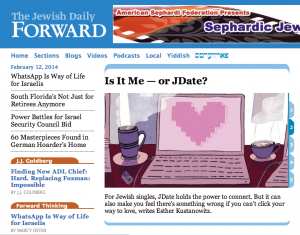 While Valentine’s Day week isn’t always a week of romance and celebration for everyone, this year, Cupid brought me two new clips to share.
While Valentine’s Day week isn’t always a week of romance and celebration for everyone, this year, Cupid brought me two new clips to share.
Last weekend in the print edition and Tuesday online, the Forward published my piece “The Jewish Lonely Hearts Who Meet Online” – about online dating sites, the blame game that singles play with each other, and how we all could take a higher road when it comes to interacting online.
Then on Facebook, we launched some midweek discussions about JDate’s advertising, when that niche dating service launched its new ad campaigns, making some laugh and others cringe. With slogans taking a pot shot at Match.com (“6000 years of persecution and now you’re joining Match.com?”) and appealing to those who are waiting to “find someone who shares your love of gefilte fish,” the slogans run from the stereotypical to the unoriginal, playing to the broadest strokes of public awareness of what defines a Jew, and what those Jews are looking for when they’re looking for love online. (You can read the NYTimes article about this new campaign here.)
In a sad note this week, but relevant to Valentine’s Day as an opportunity to share things we love with people we love, the world lost famous comedian Sid Caesar. The Jewish Journal asked me to write something – since I love writing about entertainment, TV and comedy, and did feel a bit personally connected to Caesar (even though we had never met), I wrote this piece – “My Friend’s Seder With Sid: Remembering Sid Caesar,” now featured in the Jewish Journal’s Religion section – about how virtual connections can become real, with people acting as emissaries and interceding to create real-life connections. The story contains some of my friend’s personal reflections of her time with Sid over the last year, and reminds us of how much laughter he gave the world. May his memory and his work continue to be an inspiration to those of us who dabble in or appreciate comedy. 🙂
